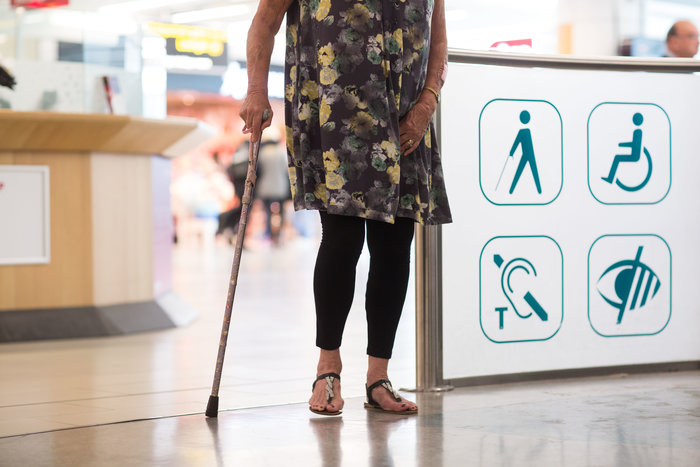Sara Marchant, accessibility manager at Gatwick Airport, tells PTT about its special assistance offering and the opening of its new targeted lounge.
What measures has Gatwick taken to become autism friendly?
Gatwick has introduced a series of measures including a Hidden Disability Lanyard, an Autism Ambassador and staff training programs to better assist passengers with autism. In 2016, Gatwick launched its first-of-its-kind lanyard for passengers with hidden disabilities who may require additional support when travelling through the airport. The lanyard, which is entirely voluntary for passengers with hidden disabilities and their families, acts as a discreet sign for staff that additional support or help may be required.
An autism friendly visual guide to travelling though Gatwick has also been produced to help those passengers with autism to familiarise themselves with what to expect at the airport in advance of their holiday. Gatwick has since been held up as an exemplar in this respect by both Government ministers and in new guidance issued to all UK airports by the CAA.
Why did Gatwick strive to become autism friendly?
Travelling through an airport can be a challenge for people with autism as they often see, hear and feel the world in a different, more intense way, and can be overwhelmed by ‘too much information’. Gatwick is an airport for everyone. We have an ambition to be the UK’s most accessible airport, where everybody has an equal opportunity to fly.
What is a typical airport experience for those with autism flying via Gatwick?
We need to make sure that all our flights are safe and secure, and that means that every passenger who travels through Gatwick will need to go through security. We understand that this can be challenging for people with autism – and a range of other disabilities – and so we created a Family and Assistance Lane that people can use at their own pace in an area dedicated to them. Of course, passengers are welcome to use the main security area if they want to, but we like to give families the choice.
There is also a quiet route that people can take from security into the departure lounge, which bypasses the shops as we know that this can sometimes feel a little overwhelming. If passengers would like to use this route, they can just ask a member of staff, who will be happy to direct them.
Why did you decide to appoint an autism ambassador?
Gatwick appointed Maria Cook as the airport’s first Autism Ambassador to drive continued improvement in the airport’s efforts to be fully autism friendly. Maria is the parent of an autistic son and as chair of Autism Support Crawley, has worked closely with Gatwick to promote Gatwick’s hidden disability lanyard programme, extend awareness training programs to immigration officers and other third party staff, raise awareness of autism through numerous airport events and instigate the development of specialist toilet and changing facilities in both Gatwick terminals – landside and airside – as well as a new sensory room in the North Terminal, which is soon to open.
How do you work with charities/organizations to ensure your offering to those with autism is the best possible?
Our Passenger Advisory Group (PAG) forms part of the formal Gatwick Airport Consultative Committee (GATCOM) and takes a keen interest in the comfort, care, safety and security of passengers using the airport. They make recommendations to Gatwick for improvements in these areas, as well as reviewing feedback from our passengers.
PAG is made up of a cross section of both regular and occasional air travelers, and they all bring some knowledge of the airport and a genuine interest in the way our services and facilities interface with passengers. We also engage with a number of organisations working with hidden disabilities, such as the National Autism Society, RNIB, Colostomy UK and Alzheimer’s Society.
What equipment/technology have you installed around the airport to aid those with disabilities?
Gatwick offers a range of services and facilities to help those with a disability of any kind or if their mobility is reduced. Throughout the airport there are a number of assistance reception desks with reserved seating where a dedicated team is on hand to help. There are also special assistance help points on both terminal forecourts, short stay car parks, stations, baggage reclaim halls and on some routes within the terminals where there are long walking distances. There are also two adult changing places located on the arrivals routes in both terminals.
These facilities are free to use and do not need to be pre-booked and are available for all arriving and departing passengers. They include an adjustable bed that lowers to ground level, a hoist and flexible wash basins, all located in a large wash room with full shower facilities. Eagle hoists are also available to all passengers who need additional assistance to board an aircraft and these are available on a first come first served basis and need to be booked at least 24 hours prior to travelling, ideally as far in advance of your journey as possible.
What are your future plans for the airport in supporting those who require special assistance?
A new premium lounge feel area for passengers who require special assistance has just been opened in the North Terminal (read more here) and is one of the largest of its kind in any European airport. The area has been designed with a premium lounge feel, providing bespoke chairs and soft furnishings to provide a quiet, calm environment for passengers to relax in before their flight.


